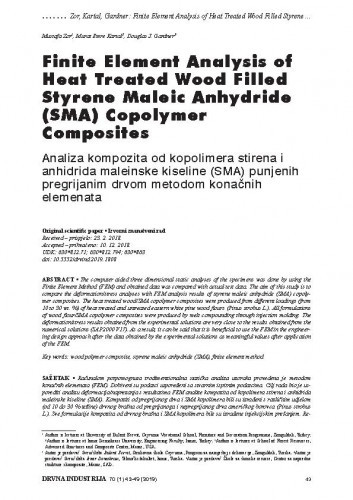The computer aided three dimensional static analyses of the specimens was done by using the Finite Element Method (FEM) and obtained data was compared with actual test data. The aim of this study is to compare the deformation/stress analyses with FEM analysis results of styrene maleic anhydride (SMA) copolymer composites. The heat treated wood/SMA copolymer composites were produced from different loadings (from 10 to 30 wt. %) of heat treated and untreated eastern white pine wood flours (Pinus strobus L.). All formulations of wood flour/SMA copolymer composites were produced by melt compounding through injection molding. The deformation/stress results obtained from the experimental solutions are very close to the results obtained from the numerical solutions (SAP2000 V17). As a result, it can be said that it is beneficial to use the FEM in the engineering design approach after the data obtained by the experimental solutions as meaningful values after application of the FEM.; Računalom potpomognuta trodimenzionalna statička analiza uzoraka provedena je metodom konačnih elemenata (FEM). Dobiveni su podatci uspoređeni sa stvarnim ispitnim podatcima. Cilj rada bio je usporediti analizu deformacija/naprezanja s rezultatima FEM analize kompozita od kopolimera stirena i anhidrida maleinske kiseline (SMA). Kompoziti od pregrijanog drva i SMA kopolimera bili su izrađeni s različitim udjelom (od 10 do 30 % težine) drvnog brašna od pregrijanoga i nepregrijanog drva američkog borovca (Pinus strobus L.). Sve formulacije kompozita od drvnog brašna i SMA kopolimera bile su izrađene injekcijskim prešanjem. Rezultati deformacija i naprezanja dobiveni eksperimentalno vrlo su slični rezultatima dobivenim računskim putem (SAP200 V17). Može se zaključiti da je analiza metodom konačnih elementa, kombinirana s eksperimentalno dobivenim podatcima, korisna u inženjerskom projektiranju.
Sažetak

 Drvna industrija : znanstveni časopis za pitanja drvne tehnologije : 70,1(2019) / glavni i odgovorni urednik Ružica Beljo-Lučić.
Drvna industrija : znanstveni časopis za pitanja drvne tehnologije : 70,1(2019) / glavni i odgovorni urednik Ružica Beljo-Lučić.